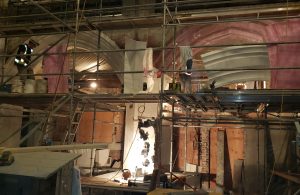Owners of heritage properties know how special these architectural time capsules are; they also know how important it is to preserve and restore them, so they’ll continue to stand the test of time. That said, heritage site renovations are no easy feat. From navigating government restrictions, to working without modern blueprints, even a simple interior upgrade can bring about unforeseen challenges.
“It’s the unknowns about the structure that cause the most difficulties for the engineers, and ultimately the building owners,” says Michael Fowlie, Associate at RJC Engineers. “When there are no plans available, it requires extensive site measurements and removing finishes to examine the condition of the building and develop an understanding of the existing structure.”
Without drawings, Fowlie says assumptions need to be made regarding the materials used and their current condition. “Even if the original plans are available, usually they will offer limited information compared to today’s blueprints—on top of which, renovations over the years may have modified the framing and resulted in more unknowns.”
What are some of the most common issues when renovating?
According to Fowlie, three major challenges include:
- Changing construction details and practices over time that have rendered parts of the structure unacceptable by today’s standards. This includes areas like the building envelope and the exposed structure. Often upgrades that weren’t anticipated are required to address these outdated, and potentially dangerous conditions.
- Maintaining the original look of construction while integrating modern details. As an example, Fowlie points to today’s use of bolts for connections whereas the original details may have been riveted. This requires special care and attention to repair.
- Knowing the limits of the building and being aware of which materials have reached their lifespan. Often there is a pull between “the building has lasted 100 years” and “the building has been there for 100 years.” At some point, materials will have reached the end of their life cycle.
Surprise! The hidden costs of renovations
In terms of “surprise” issues that can arise on a typical heritage renovation project, Fowlie says there are usually plenty of those. As such, additional costs should be anticipated by the owner for repairs that come about once the digging begins.
“While the building itself may have stood for decades, the structure will likely require extensive repairs to ensure it’s next life-cycle,” Fowlie explains. “This is especially true of old brick and wood buildings, especially if they were abandoned even for a short time period.”
Furthermore, some buildings that have been significantly modified in a previous era, may have older, unknown elements that are buried or hidden away. It’s also possible that a fully restored historical building repurposed for a new use has areas with load limits or other issues that will limit the type of future use for the property.
 In terms of preserving the aesthetic, Fowlie says the key is to determine which repairs are essential versus which areas can be left in their original form. It’s a critical balancing act that must be achieved to maintain a building’s look while prolonging its useful service life. He offers the example of a 100-year-old heritage site his team is currently restoring, highlighting the importance of taking the right steps to ensure all parties are satisfied with the outcome.
In terms of preserving the aesthetic, Fowlie says the key is to determine which repairs are essential versus which areas can be left in their original form. It’s a critical balancing act that must be achieved to maintain a building’s look while prolonging its useful service life. He offers the example of a 100-year-old heritage site his team is currently restoring, highlighting the importance of taking the right steps to ensure all parties are satisfied with the outcome.
“We have worked collaboratively with the owner, architect and contractor to expose the structure and develop a plan to repair the building,” he says of the ongoing work. “While the job has provided many challenges and surprises, we are currently rehabilitating the building for use by a tenant and to maintain its historical look and uniqueness. We’re anticipating great results.”
For more information on building renovations, please visit www.rjc.ca or contact Michael Fowlie directly at: mfowlie@rjc.ca









